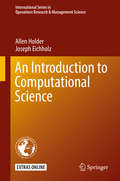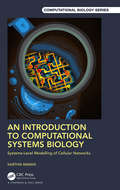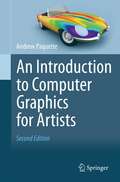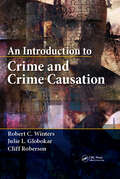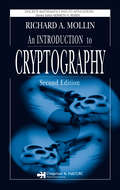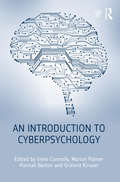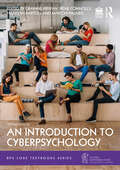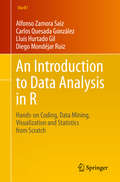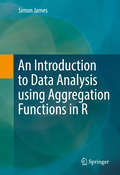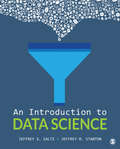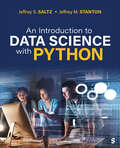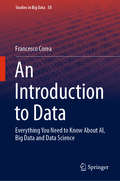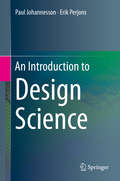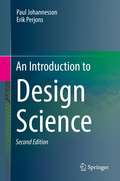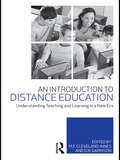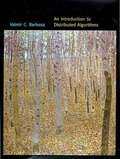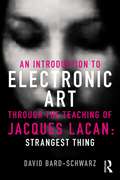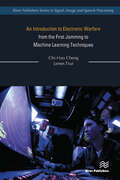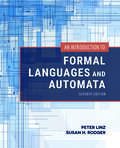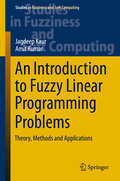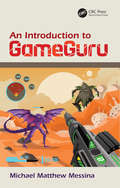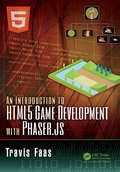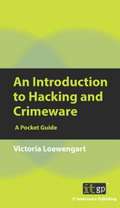- Table View
- List View
An Introduction to Computational Science (International Series in Operations Research & Management Science #278)
by Allen Holder Joseph EichholzThis textbook provides an introduction to the growing interdisciplinary field of computational science. It combines a foundational development of numerical methods with a variety of illustrative applications spread across numerous areas of science and engineering. The intended audience is the undergraduate who has completed introductory coursework in mathematics and computer science. Students gain computational acuity by authoring their own numerical routines and by practicing with numerical methods as they solve computational models. This education encourages students to learn the importance of answering: How expensive is a calculation, how trustworthy is a calculation, and how might we model a problem to apply a desired numerical method?The text is written in two parts. Part I provides a succinct, one-term inauguration into the primary routines on which a further study of computational science rests. The material is organized so that the transition to computational science from coursework in calculus, differential equations, and linear algebra is natural. Beyond the mathematical and computational content of Part I, students gain proficiency with elemental programming constructs and visualization, which are presented in MATLAB syntax. The focus of Part II is modeling, wherein students build computational models, compute solutions, and report their findings. The models purposely intersect numerous areas of science and engineering to demonstrate the pervasive role played by computational science.
An Introduction to Computational Systems Biology: Systems-Level Modelling of Cellular Networks (Chapman & Hall/CRC Computational Biology Series)
by Karthik Raman"This is a very comprehensive read that provides a solid base in computational biology. The book is structured in 4 parts and 14 chapters which cover all the way from the more basic concepts to advanced material, including the state-of-the-art methodologies in synthetic and systems biology. This is a bedside book for those researchers embarking to do investigation in computational biology and a great office companion for anyone working on systems and synthetic biology." -- Rodrigo Ledesma Amaro, Lecturer, Imperial College London "This is a fantastic book. It offers an elegant introduction to both classical and modern concepts in computational biology. To the uninitiated, it is a terrific first read, bringing alive the glory of the past and the promise of the future. To the interested, it handholds and offers a springboard to dive deep. To the practitioner, it serves as a valuable resource bringing together in a panoramic view many diverse streams that adorn the landscape." -- Narendra M. Dixit, Professor, Indian Institute of Science An Introduction to Computational Systems Biology: Systems-Level Modelling of Cellular Networks delivers a comprehensive and insightful account of applying mathematical modelling approaches to very large biological systems and networks—a fundamental aspect of computational systems biology. The book covers key modelling paradigms in detail, while at the same time retaining a simplicity that will appeal to those from less quantitative fields. Features A hands-on approach to modelling Covers a broad spectrum of modelling, from static networks to dynamic models and constraint-based models Thoughtful exercises to test and enable understanding of concepts State-of-the-art chapters on exciting new developments like community modelling and biological circuit design Emphasis on coding and software tools for systems biology This book is highly multi-disciplinary and will appeal to biologists, engineers, computer scientists, mathematicians and others.
An Introduction to Computer Graphics for Artists
by Andrew PaquetteAn Introduction to Computer Graphics for Artists is an application-independent, reader-friendly primer for anyone with a serious desire to understand 3D Computer Graphics. Written by a veteran of the computer graphics industry whose previous career included film animation and various spells as Art Director for video games, Andrew Paquette draws on his experiences both as an artist and a manager. Far too often artists, even professionals, lack a basic understanding of the principles of computer graphics. The result is inefficiency and lower quality of work. This book addresses these issues by providing fundamental information in a university course format, with theoretical material, detailed illustrations, and projects to test the reader's understanding of the concepts covered. Opening with the first and most basic elements of computer graphics, the book rapidly advances into progressively more complex concepts. Each of the elements, however simple, are important to understand because each is an essential link in a chain that allows an artist to master any computer graphics application. With this accomplished, the artist can use technology to satisfy his goals, instead of the technology being master of the artist. All students wanting to learn more about computer graphics from an artistic viewpoint, particularly those intending to pursue a career in computer game design or film animation, will find this book invaluable.
An Introduction to Crime and Crime Causation
by Cliff Roberson Robert C. Winters Julie L. GlobokarAn Introduction to Crime and Crime Causation is a student-friendly textbook that defines and explains the concepts of crime, criminal law, and criminology. Ideal for a one-semester course, the book compares and contrasts early criminal behavior and today‘s modern forms of crime. It also explores society‘s responses to criminal behavior in the past
An Introduction to Cryptography (Discrete Mathematics and Its Applications)
by Richard A. MollinContinuing a bestselling tradition, An Introduction to Cryptography, Second Edition provides a solid foundation in cryptographic concepts that features all of the requisite background material on number theory and algorithmic complexity as well as a historical look at the field.With numerous additions and restructured material, this edition
An Introduction to Cyberpsychology
by Irene Connolly, Palmer Marion, Barton Hannah and Kirwan GráinneAn Introduction to Cyberpsychology is the first book to provide a student-oriented introduction to this rapidly growing and increasingly studied topic. It is designed to encourage students to critically evaluate the psychology of online interactions, and to develop appropriate research methodologies to complete their own work in this field. The book is comprised of four main sections: An overview of cyberpsychology and online research methodologies Social psychology in an online context The practical applications of cyberpsychology The psychological aspects of other technologies. Each chapter includes: Explanations of key terms and a glossary to facilitate understanding Content summaries to aid student learning Activity boxes, discussion questions and recommended reading to guide further study. Further resources for students and instructors are available on the book’s companion website, including audio and video links, essay questions, a multiple-choice test bank, and PowerPoint lecture slides. Uniquely combining a survey of the field with a focus on the applied areas of psychology, the book is designed to be a core text for undergraduate modules in cyberpsychology and the psychology of the internet, and a primer for students of postgraduate programs in cyberpsychology.
An Introduction to Cyberpsychology (BPS Core Textbooks Series)
by Gráinne Kirwan, Irene Connolly, Hannah Barton, and Marion PalmerAn Introduction to Cyberpsychology provides a comprehensive introduction to this rapidly growing discipline. Fully updated in its second edition, the book encourages students to critically evaluate the psychology of online interactions and to develop appropriate research methodologies to complete their own work in this field.The book examines cyberpsychology and online research methodologies, social psychology in an online context, practical applications of cyberpsychology, and the psychological aspects of other technologies. This new edition has been carefully updated to include additional coverage of: Expanded content relating to major developments in the field and new content on gaming and screentime A new chapter examining the relationship between older adults and technology Cyberpsychology in focus feature boxes in each chapter that examine topics in depth Interviews with professionals working in fields relating to cyberpsychology Each chapter includes key terms and a glossary, content summaries, discussion questions, and recommended reading to guide further study.Supported by extensive online resources for students and instructors, this authoritative book is an essential core text for undergraduate modules in cyberpsychology, and an ideal primer for students of postgraduate programs in cyberpsychology.To view the additional student and instructor resources for this book, please visit bpscoretextbooks.routledge.com
An Introduction to Data Analysis in R: Hands-on Coding, Data Mining, Visualization and Statistics from Scratch (Use R!)
by Alfonso Zamora Saiz Carlos Quesada González Lluís Hurtado Gil Diego Mondéjar RuizThis textbook offers an easy-to-follow, practical guide to modern data analysis using the programming language R. The chapters cover topics such as the fundamentals of programming in R, data collection and preprocessing, including web scraping, data visualization, and statistical methods, including multivariate analysis, and feature exercises at the end of each section. The text requires only basic statistics skills, as it strikes a balance between statistical and mathematical understanding and implementation in R, with a special emphasis on reproducible examples and real-world applications. This textbook is primarily intended for undergraduate students of mathematics, statistics, physics, economics, finance and business who are pursuing a career in data analytics. It will be equally valuable for master students of data science and industry professionals who want to conduct data analyses.
An Introduction to Data Analysis using Aggregation Functions in R
by Simon JamesThis textbook helps future data analysts comprehend aggregation function theory and methods in an accessible way, focusing on a fundamental understanding of the data and summarization tools. Offering a broad overview of recent trends in aggregation research, it complements any study in statistical or machine learning techniques. Readers will learn how to program key functions in R without obtaining an extensive programming background. Sections of the textbook cover background information and context, aggregating data with averaging functions, power means, and weighted averages including the Borda count. It explains how to transform data using normalization or scaling and standardization, as well as log, polynomial, and rank transforms. The section on averaging with interaction introduces OWS functions and the Choquet integral, simple functions that allow the handling of non-independent inputs. The final chapters examine software analysis with an emphasis on parameter identification rather than technical aspects. This textbook is designed for students studying computer science or business who are interested in tools for summarizing and interpreting data, without requiring a strong mathematical background. It is also suitable for those working on sophisticated data science techniques who seek a better conception of fundamental data aggregation. Solutions to the practice questions are included in the textbook.
An Introduction to Data Science
by Jeffrey S. Saltz Jeffrey Morgan StantonAn Introduction to Data Science is an easy-to-read, gentle introduction for advanced undergraduate, certificate, and graduate students coming from a wide range of backgrounds into the world of data science. After introducing the basic concepts of data science, the book builds on these foundations to explain data science techniques using the R programming language and RStudio® from the ground up. Short chapters allow instructors to group concepts together for a semester course and provide students with manageable amounts of information for each concept. By taking students systematically through the R programming environment, the book takes the fear out of data science and familiarizes students with the environment so they can be successful when performing advanced functions. The authors cover statistics from a conceptual standpoint, focusing on how to use and interpret statistics, rather than the math behind the statistics. This text then demonstrates how to use data effectively and efficiently to construct models, predict outcomes, visualize data, and make decisions. Accompanying digital resources provide code and datasets for instructors and learners to perform a wide range of data science tasks.
An Introduction to Data Science
by Jeffrey S. Saltz Jeffrey Morgan StantonAn Introduction to Data Science is an easy-to-read, gentle introduction for advanced undergraduate, certificate, and graduate students coming from a wide range of backgrounds into the world of data science. After introducing the basic concepts of data science, the book builds on these foundations to explain data science techniques using the R programming language and RStudio® from the ground up. Short chapters allow instructors to group concepts together for a semester course and provide students with manageable amounts of information for each concept. By taking students systematically through the R programming environment, the book takes the fear out of data science and familiarizes students with the environment so they can be successful when performing advanced functions. The authors cover statistics from a conceptual standpoint, focusing on how to use and interpret statistics, rather than the math behind the statistics. This text then demonstrates how to use data effectively and efficiently to construct models, predict outcomes, visualize data, and make decisions. Accompanying digital resources provide code and datasets for instructors and learners to perform a wide range of data science tasks.
An Introduction to Data Science With Python
by Jeffrey S. Saltz Jeffrey Morgan StantonAn Introduction to Data Science with Python by Jeffrey S. Saltz and Jeffery M. Stanton provides readers who are new to Python and data science with a step-by-step walkthrough of the tools and techniques used to analyze data and generate predictive models. After introducing the basic concepts of data science, the book builds on these foundations to explain data science techniques using Python-based Jupyter Notebooks. The techniques include making tables and data frames, computing statistics, managing data, creating data visualizations, and building machine learning models. Each chapter breaks down the process into simple steps and components so students with no more than a high school algebra background will still find the concepts and code intelligible. Explanations are reinforced with linked practice questions throughout to check reader understanding. The book also covers advanced topics such as neural networks and deep learning, the basis of many recent and startling advances in machine learning and artificial intelligence. With their trademark humor and clear explanations, Saltz and Stanton provide a gentle introduction to this powerful data science tool. Included with this title: LMS Cartridge: Import this title’s instructor resources into your school’s learning management system (LMS) and save time. Don′t use an LMS? You can still access all of the same online resources for this title via the password-protected Instructor Resource Site.
An Introduction to Data Science With Python
by Jeffrey S. Saltz Jeffrey Morgan StantonAn Introduction to Data Science with Python by Jeffrey S. Saltz and Jeffery M. Stanton provides readers who are new to Python and data science with a step-by-step walkthrough of the tools and techniques used to analyze data and generate predictive models. After introducing the basic concepts of data science, the book builds on these foundations to explain data science techniques using Python-based Jupyter Notebooks. The techniques include making tables and data frames, computing statistics, managing data, creating data visualizations, and building machine learning models. Each chapter breaks down the process into simple steps and components so students with no more than a high school algebra background will still find the concepts and code intelligible. Explanations are reinforced with linked practice questions throughout to check reader understanding. The book also covers advanced topics such as neural networks and deep learning, the basis of many recent and startling advances in machine learning and artificial intelligence. With their trademark humor and clear explanations, Saltz and Stanton provide a gentle introduction to this powerful data science tool. Included with this title: LMS Cartridge: Import this title’s instructor resources into your school’s learning management system (LMS) and save time. Don′t use an LMS? You can still access all of the same online resources for this title via the password-protected Instructor Resource Site.
An Introduction to Data: Everything You Need to Know About AI, Big Data and Data Science (Studies in Big Data #50)
by Francesco CoreaThis book reflects the author’s years of hands-on experience as an academic and practitioner. It is primarily intended for executives, managers and practitioners who want to redefine the way they think about artificial intelligence (AI) and other exponential technologies. Accordingly the book, which is structured as a collection of largely self-contained articles, includes both general strategic reflections and detailed sector-specific information. More concretely, it shares insights into what it means to work with AI and how to do it more efficiently; what it means to hire a data scientist and what new roles there are in the field; how to use AI in specific industries such as finance or insurance; how AI interacts with other technologies such as blockchain; and, in closing, a review of the use of AI in venture capital, as well as a snapshot of acceleration programs for AI companies.
An Introduction to Design Science
by Paul Johannesson Erik PerjonsThis book is an introductory text on design science, intended to support both graduate students and researchers in structuring, undertaking and presenting design science work. It builds on established design science methods as well as recent work on presenting design science studies and ethical principles for design science, and also offers novel instruments for visualizing the results, both in the form of process diagrams and through a canvas format. While the book does not presume any prior knowledge of design science, it provides readers with a thorough understanding of the subject and enables them to delve into much deeper detail, thanks to extensive sections on further reading. Design science in information systems and technology aims to create novel artifacts in the form of models, methods, and systems that support people in developing, using and maintaining IT solutions. This work focuses on design science as applied to information systems and technology, but it also includes examples from, and perspectives of, other fields of human practice. Chapter 1 provides an overview of design science and outlines its ties with empirical research. Chapter 2 discusses the various types and forms of knowledge that can be used and produced by design science research, while Chapter 3 presents a brief overview of common empirical research strategies and methods. Chapter 4 introduces a methodological framework for supporting researchers in doing design science research as well as in presenting their results. This framework includes five core activities, which are described in detail in Chapters 5 to 9. Chapter 10 discusses how to communicate design science results, while Chapter 11 compares the proposed methodological framework with methods for systems development and shows how they can be combined. Chapter 12 discusses how design science relates to research paradigms, in particular to positivism and interpretivism. Lastly, Chapter 13 discusses ethical issues and principles for design science research.
An Introduction to Design Science
by Paul Johannesson Erik PerjonsThis book is an introductory text on design science, intended to support both graduate students and researchers in structuring, undertaking and presenting design science work. It builds on established design science methods as well as recent work on presenting design science studies and ethical principles for design science, and also offers novel instruments for visualizing the results, both in the form of process diagrams and through a canvas format. While the book does not presume any prior knowledge of design science, it provides readers with a thorough understanding of the subject and enables them to delve into much deeper detail, thanks to extensive sections on further reading. Design science in information systems and technology aims to create novel artifacts in the form of models, methods, and systems that support people in developing, using and maintaining IT solutions. This work focuses on design science as applied to information systems and technology, but it also includes examples from, and perspectives of, other fields of human practice. Chapter 1 provides an overview of design science and outlines its ties with empirical research. Chapter 2 discusses the various types and forms of knowledge that can be used and produced by design science research, while Chapter 3 presents a brief overview of common empirical research strategies and methods. Chapter 4 introduces a methodological framework for supporting researchers in doing design science research as well as in presenting their results. This framework includes five core activities, which are described in detail in Chapters 5 to 9. Chapter 10 discusses how to communicate design science results, while Chapter 11 compares the proposed methodological framework with methods for systems development and shows how they can be combined. Chapter 12 discusses how design science relates to research paradigms, in particular to positivism and interpretivism, and Chapter 13 discusses ethical issues and principles for design science research. The new Chapter 14 showcases a study on digital health consultations and illustrates the whole process in one comprehensive example. Also added to this 2nd edition are a number of sections on practical guidelines for carrying out basic design science tasks, a discussion on design thinking and its relationship to design science, and the description of artefact classifications. Eventually, both the references in each chapter and the companion web site were updated to reflect recent findings.
An Introduction to Distance Education: Understanding Teaching and Learning in a New Era
by M.F. Cleveland-Innes D. R. GarrisonAn Introduction to Distance Education is a comprehensive look at the field today, outlining current theories, practices and goals. The book reviews the influence of past distance education theory and practice, along with current changes. It outlines the practical skills and information that are essential to effective distance education design, delivery and navigation. This volume brings together seminal contributors who have and who are currently researching and shaping our understanding and practice of distance education. A discussion of past and present practices in higher and distance education leads to an understanding of accessible education and the appropriate use of Web 2.0 technology. Utilizing a student-guided approach, each chapter offers pedagogical features to engage and support the teaching and learning process, including: questions for reflection, review and discussion: students can use these questions as triggers for further thoughts related to the topic. Instructors can use these questions for classroom and online discussion key quotations: strategically placed throughout the text, these points act as a springboard for further reflection and classroom discussion concept definitions: central concepts discussed in the text are defined or students at the end of each chapter. A perfect textbook for educational technology Doctorate, Masters and Certificate programs, students will find An Introduction to Distance Education offers a solid foundation from which to explore and develop new approaches to designing and implementing online courses.
An Introduction to Distributed Algorithms
by Valmir C. BarbosaAn Introduction to Distributed Algorithms takes up some of the main concepts and algorithms, ranging from basic to advanced techniques and applications, that underlie the programming of distributed-memory systems such as computer networks, networks of workstations, and multiprocessors. Written from the broad perspective of distributed-memory systems in general it includes topics such as algorithms for maximum flow, program debugging, and simulation that do not appear in more orthodox texts on distributed algorithms. Moving from fundamentals to advances and applications, ten chapters--with exercises and bibliographic notes--cover a variety of topics. These include models of distributed computation, information propagation, leader election, distributed snapshots, network synchronization, self- stability, termination detection, deadlock detection, graph algorithms, mutual exclusion, program debugging, and simulation. All of the algorithms are presented in a clear, template- based format for the description of message-passing computations among the nodes of a connected graph. Such a generic setting allows the treatment of problems originating from many different application areas. The main ideas and algorithms are described in a way that balances intuition and formal rigor--most are preceded by a general intuitive discussion and followed by formal statements as to correctness complexity or other properties.
An Introduction to Electronic Art Through the Teaching of Jacques Lacan: Strangest Thing
by David Bard-SchwarzElectronic art offers endless opportunities for reflection and interpretation. Works can be interactive or entirely autonomous and the viewer's perception and reaction to them may be challenged by constantly transforming images. Whether the transformations are a product of the appearances or actions of a viewer in an installation space, or a product of a self-contained computer program, is a source of constant fascination. Some viewers may feel strange or unnerved by a work, while others may feel welcoming, humorous, and playful emotions. The art may also provoke a critical response to social, aesthetic, and political aspects of early twenty-first-century life. This book approaches electronic art through the teachings of Jacques Lacan, whose return to Freud has exerted a powerful and wide-ranging influence on psychoanalysis and critical theory in the twentieth century. David Bard-Schwarz draws on his experience with Lacanian psychoanalysis, music, and interactive and traditional arts in order to address aspects of the works the viewer may find difficult to understand. Dividing his approach over four thematic chapters—Bodies, Voices, Eyes, and Signifiers—Bard-Schwarz explores the links between works of new media and psychoanalysis (how we process what we see, hear, touch, imagine, and remember). This is a fascinating book for new media artists and critics, museum curators, psychologists, students in the fine arts, and those who are interested in digital technology and contemporary culture.
An Introduction to Electronic Warfare; from the First Jamming to Machine Learning Techniques
by Chi-Hao Cheng James TsuiSince its creation at the beginning of World II, radars have forever transformed the practice of modern warfare. The evolution of countermeasure conducted by electronic warfare systems against radars and radars’ corresponding counter countermeasures is an intriguing technical subject. This book provides a very accessible introduction to a broad range of radar and electronic warfare technologies. The subjects covered in this book range from early radar development to later technologies such as stealthy techniques, low probability of intercept radar, and machine learning. Historical events are used to illustrate the principles of electronic warfare and to help readers to apprehend contexts under which radars and corresponding electronic warfare techniques were developed.
An Introduction to Formal Languages and Automata
by Peter Linz Susan H. RodgerAn Introduction to Formal Languages and Automata, Seventh Edition is designed for an introductory course on formal languages, automata, compatibility, and related matters forming what is known as the theory of computation.
An Introduction to Fuzzy Linear Programming Problems: Theory, Methods and Applications (Studies in Fuzziness and Soft Computing #340)
by Amit Kumar Jagdeep KaurThe book presents a snapshot of the state of the art in the field of fully fuzzy linear programming. The main focus is on showing current methods for finding the fuzzy optimal solution of fully fuzzy linear programming problems in which all the parameters and decision variables are represented by non-negative fuzzy numbers. It presents new methods developed by the authors, as well as existing methods developed by others, and their application to real-world problems, including fuzzy transportation problems. Moreover, it compares the outcomes of the different methods and discusses their advantages/disadvantages. As the first work to collect at one place the most important methods for solving fuzzy linear programming problems, the book represents a useful reference guide for students and researchers, providing them with the necessary theoretical and practical knowledge to deal with linear programming problems under uncertainty.
An Introduction to GameGuru
by Michael Matthew MessinaGame-Guru is an entry-level engine designed to be easy to use as well as being extremely accessible for the user. This book gives users the information needed to access the full depth of features available in the program. Details on how to perform more complex tasks are not found easily anywhere else or in any of the Game-Guru documentation. This book will cover all of the common topics including building levels, coding, AI and more. Key Features The only book the fully covers the Game-Guru engine Includes robust documentation to perform complex tasks that are not outlined anywhere else Includes level building, coding, AI and more Included are scripts and demo maps for readers to learn from An Introduction to Game Guru is the ultimate start-to-finish guide Michael is the Chief Linux Systems Engineer for a Fortune 500 company Includes many custom assets for your own project!
An Introduction to HTML5 Game Development with Phaser.js
by Travis FaasExperience the thrill of crafting your own HTML5 game with Phaser.js game engine. HTML5 and modern JavaScript game engines have helped revolutionized web based games. Each chapter in An Introduction to HTML5 Game Development with Phaser.js showcases a sample game that illustrates an aspect of Phaser.js (now Lazer.js) that can be used as is, or in remixed games of the developer’s design. Each of these examples help the reader to understand how to optimize JavaScript game development with modern project tooling like Grunt and Bower. Though the world of HTML game development continues to grow and evolve, An Introduction to HTML5 Game Development with Phaser.js, provides a grounded resource and vital learning tool to anyone looking to optimize web game development process. Key Features Chapter objectives and examples with sample code make concepts easy to grasp Master questions and chapter summaries further help to solidify these concepts Feature boxes that contain important hints and things to note help keep readers on the right path This book uses a "building blocks" approach to game development and starts with the technology required to get things running Each chapter will be a small sample game that demonstrates one piece of Phaser.js, giving the reader time to grasp and understand the core concepts Subsequent chapters will demonstrate new features, building upon the knowledge of previous examples
An Introduction to Hacking and Crimeware
by Victoria LoewengartDefend your business, protect your livelihood, safeguard your future. Cybercrime is on the rise. Unchecked, it could destroy the entire global cyber infrastructure and wipe out many businesses. We need to defend ourselves against it, and we must fight back. Toolkits to create malware are now readily available to anyone wishing to defraud and do damage. For your business to survive and thrive, it is vital to stay informed about the threats and the risks, and arm yourself against them. Know your enemyAn Introduction to Hacking & Crimeware is a comprehensive guide to the most recent and the more serious threats. Knowing about these threats will help you understand how to ensure that your computer systems are protected and that your business is safe, enabling you to focus on your core activities. Fighting backIn this pocket guide, the author:defines exactly what crimeware is _ both intentional and unintentional _ and gives specific, up-to-date examples to help you identify the risks and protect your businessexplores the increasing use of COTS tools as hacking tools, exposing the enemy_s tactics gives practical suggestions as to how you can fight backprovides a valuable list of up-to-date, authoritative sources of information, so you can stay abreast of new developments and safeguard your business.
